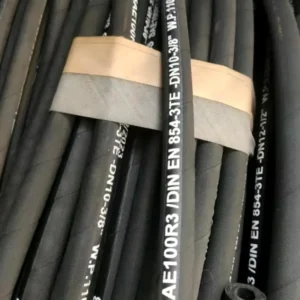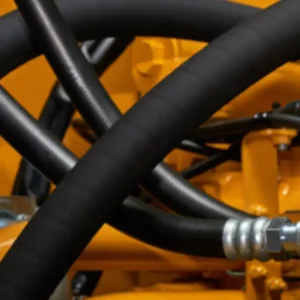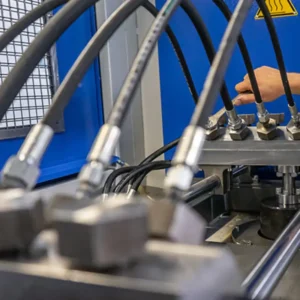Properly cutting braided fuel hoses is crucial yet often overlooked. A clean, professional cut isn’t just about aesthetics; it’s about ensuring a leak-free, secure connection. A frayed or uneven cut can compromise the seal, leading to leaks, performance issues, and even fire. This guide will teach you the proper tools, preparation, and our step-by-step method for achieving a perfect cut every time.
Why is Proper Braided Fuel Hose Cutting So Important?
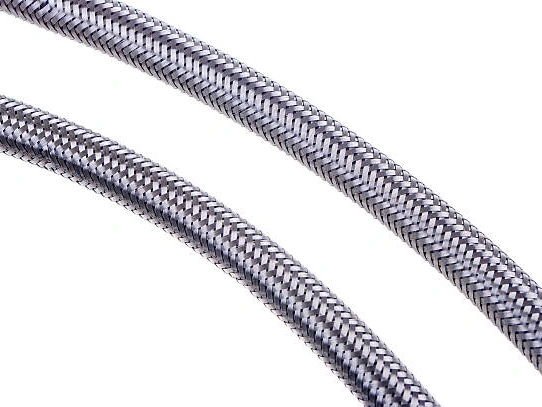
Cutting a braided fuel hose isn’t as simple as using a pair of scissors. The stainless steel or aramid fiber braid is designed to be tough and resistant to cuts. Using the wrong tool or technique can cause the braid to fray, making it nearly impossible to install the fittings correctly.
A frayed braid can also lead to a poor seal between the hose and the fitting, potentially causing a dangerous fuel leak. We always stress to our customers that the integrity of the entire fuel system depends on a clean, professional cut.
| Common Mistake | Potential Consequence |
| Using dull or incorrect cutters | Severely frayed braid, leading to a poor seal. |
| Not taping the hose before cutting | Braid separates from the inner tube. |
| Making a crooked cut | Fittings won’t seat properly, causing a leak. |
What is the Best Thing to Cut Braided Line With?
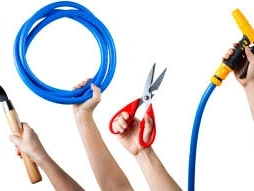
Over the years, we’ve found that having the right tools makes all the difference when it comes to a clean cut. We don’t recommend a saw or a standard pair of snips, as these tools are guaranteed to fray the braid. We’ve tried a variety of methods and have narrowed it down to a few essential items. The right tool will create a clean, sharp cut that keeps the braid intact and ready for fitting installation.
Specialized Hose Cutters
This is our top recommendation for cutting stainless steel braided hose. These cutters feature a sharp, V-shaped or scissor-style blade specifically designed to slice through the hose without crushing the core or fraying the braid. They provide a precise, straight cut that is essential for a secure fitting. We invest in high-quality cutters to ensure we can consistently achieve a clean cut for every job.
Abrasive Cut-Off Wheel
For thicker hoses or those with a heavier braid, an abrasive cut-off wheel on a high-speed grinder is an effective method. This approach requires more care but can produce a very clean cut. We always recommend wearing full personal protective equipment (PPE) when using this method, including safety glasses and gloves. Abrasive wheels generate heat, which can fuse the stainless steel braid together at the cut point, preventing fraying.
Sharp Metal Blade (Last Resort)
While not our preferred method, a very sharp metal blade (like a utility knife or hacksaw) can work in a pinch. However, this method almost always requires the use of tape to prevent fraying. We only use this method when other options aren’t available and we need to be extra meticulous with our preparation. It’s a slower and more labor-intensive process, and we find it rarely gives the same clean result as dedicated tools.
How to Cut Braided Fuel Hose
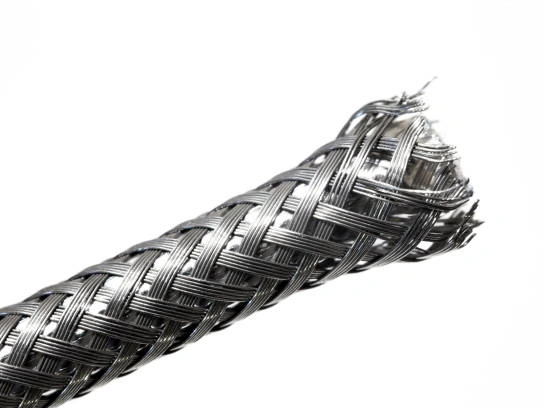
We follow a strict procedure to ensure every cut is perfect. This process minimizes fraying and prepares the hose for a secure and leak-free fitting installation.
Step 1: Measure and Mark the Hose
First, we carefully measure the required length of the braided fuel hose. We always measure twice and cut once. We then use a piece of masking tape to mark the exact point where the cut will be made.
Step 2: Tape the Hose
This is the most critical step for preventing fraying. We wrap a piece of strong tape, such as electrical tape or high-quality masking tape, tightly around the hose exactly where we marked the cut. The tape should cover an area slightly wider than the cutting tool. This tape holds the braided strands firmly in place as we cut, ensuring they don’t separate.
Step 3: Make the Cut
Using our preferred tool—usually the specialized braided hose cutters—we place the blade directly over the center of the taped area. We apply firm, steady pressure to make a single, decisive cut. We don’t saw back and forth, as this can still cause fraying. The goal is to slice through all layers of the hose in one clean motion.
Step 4: Inspect the Cut
After making the cut, we immediately inspect the end of the hose. We look for a clean, straight edge and minimal fraying. If we’ve done it correctly, the tape should still be holding the braid tightly in place. The inner rubber core should be visible and flush with the end of the braid.
Step 5: Remove the Tape and Prepare for Fitting
Carefully remove the tape from the hose. The braid should remain intact and neat. We then gently push back the braid to expose the inner tube, allowing for easy installation of the fitting. This method ensures a perfect fit and a secure, long-lasting connection.
What Are the Key Considerations for a Professional Cut?
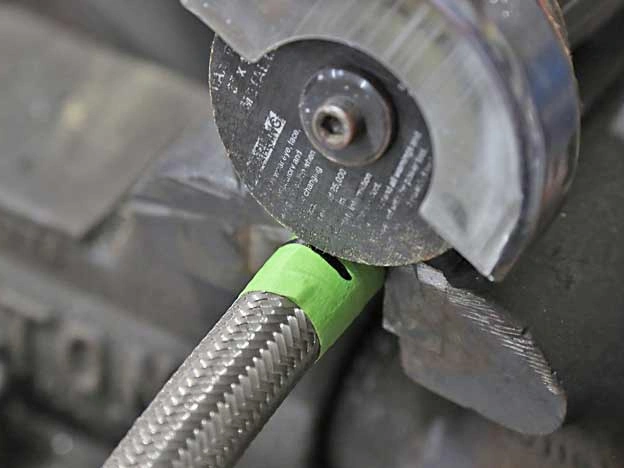
Beyond the tools and steps, there are a few other factors we consider when cutting braided hose to ensure the highest quality work.
- Tool Sharpness: We regularly sharpen our cutters or replace the blades on our cut-off wheels. A dull tool is the number one cause of a bad cut.
- Safety First: We always wear safety glasses when cutting braided hose, especially with an abrasive wheel, as metal shards can fly off.
- Know Your Materials: The method you use might depend on the hose material. Aramid fiber braids (like Kevlar) are best cut with a very sharp blade, while stainless steel braids can handle abrasive wheels. We always confirm the hose type before starting.
Conclusion
Properly cutting braided fuel hose directly impacts the safety and performance of any fuel system. By using the proper tools, following our proven step-by-step process, and paying attention to detail, you’ll achieve professional-quality cuts that ensure reliable, leak-free connections.

